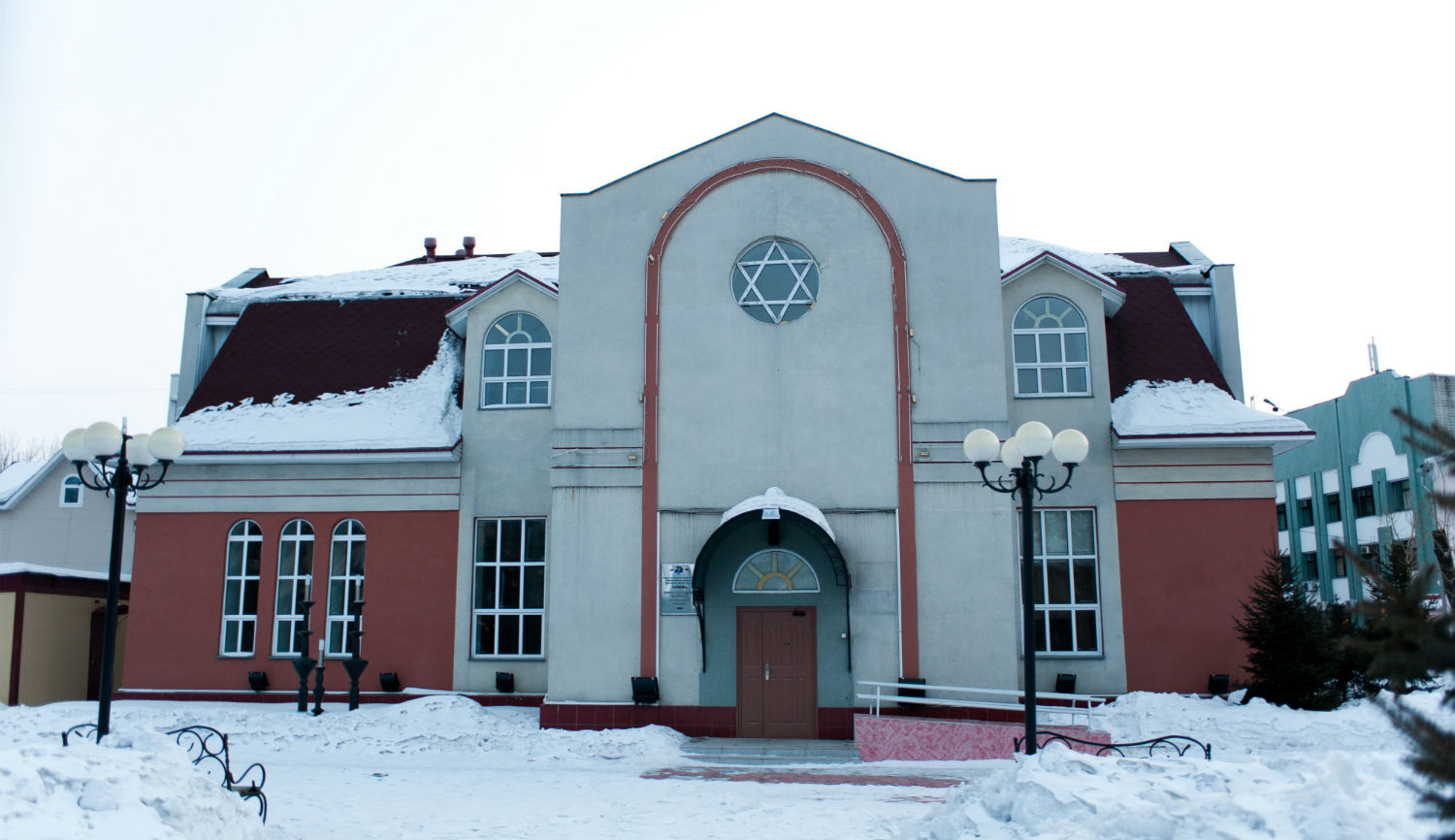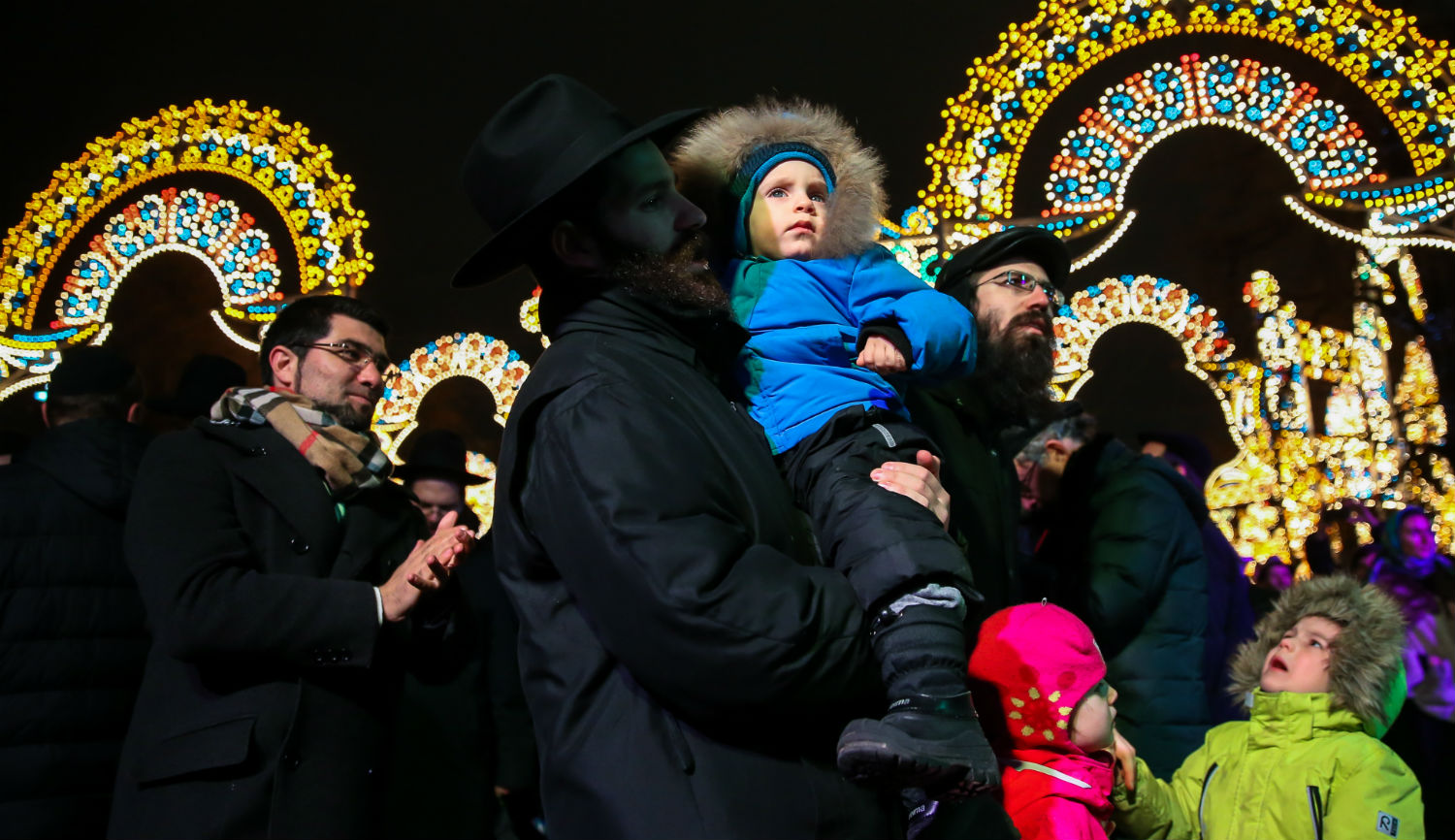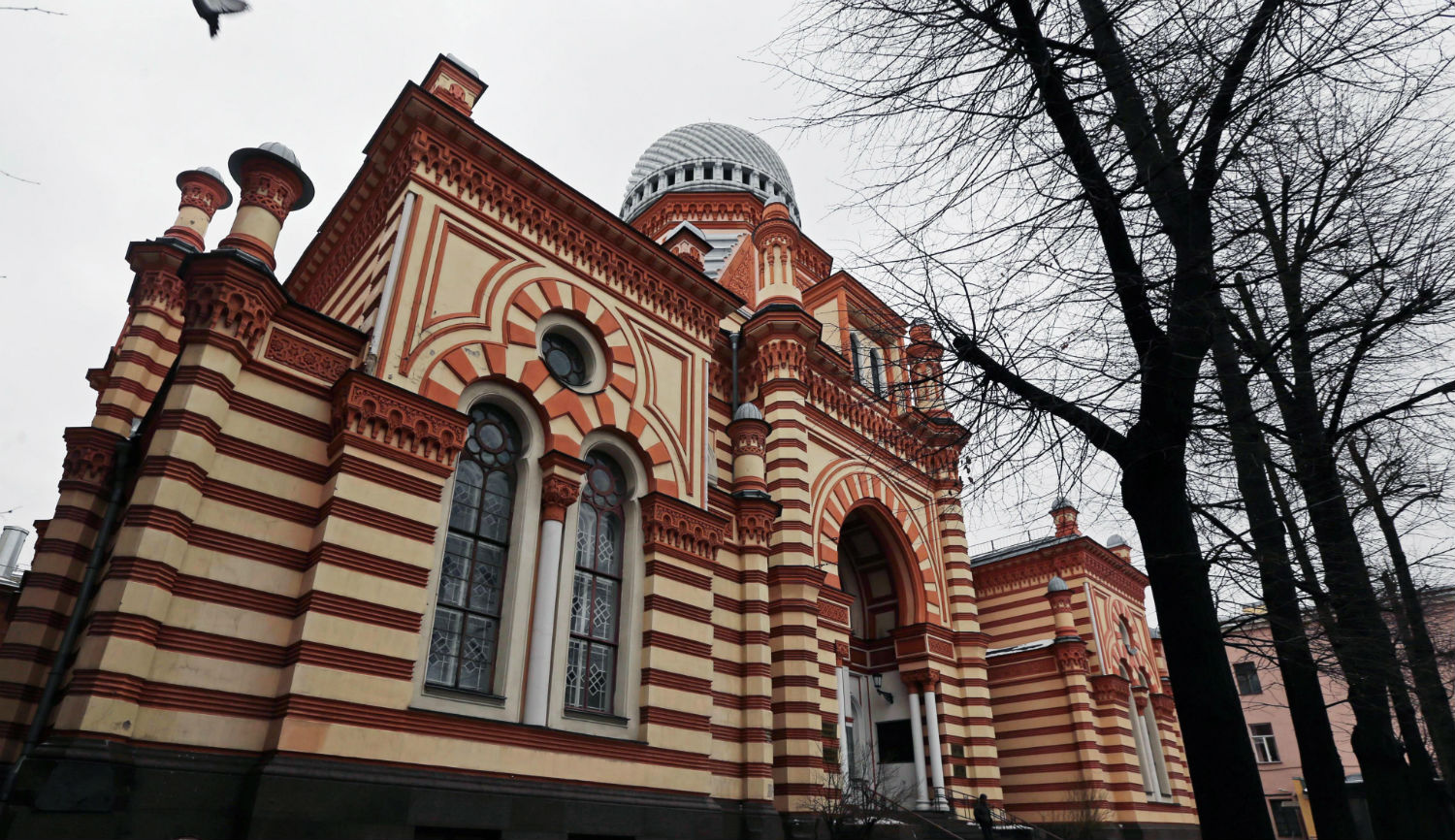I read with great interest Maxim Shrayer’s elegantly composed “The Prospect for Russia’s Jews.” Striking an especially strong chord with me were his memories of growing up as the child of refuseniks in the Soviet Union, since my parents, too, were refuseniks. (Our family finally won permission to leave in 1985.) Elsewhere in his essay, however, Shrayer exhibits a dismaying lack of familiarity with important historical aspects of the Russian Jewish scene, a constraint that colors his analysis of the situation today.
In particular, Shrayer presents the salient success of the Chabad-Lubavitch movement in today’s Russia as a relatively recent phenomenon, one whose origins are traceable to the collapse of the Soviet Union in the early 1990s—which is also when Rabbi Berel Lazar, the head Chabad emissary in the region, arrived on the scene. Shrayer is not alone in this; others who write on the subject adhere to a similar narrative, tending to attribute much of Chabad’s success to the purportedly close relationship that Lazar enjoys with the Russian president, Vladimir Putin. Taking this narrative at face value, Shrayer adduces in confirmation a speech that he heard Lazar give in Moscow late last year.
In what follows I’ll try to offer a brief corrective to this misimpression; but first let me disclose my interest. A New York-based writer and editor at Chabad.org, the movement’s online presence, I speak neither for the website nor for the Chabad movement as a whole; moreover, the website itself has no formal connection with Chabad of Russia or with the Federation of Jewish Communities in the former Soviet Union. I have, however, devoted much time to researching and writing about Jews in the area, both their history and their current challenges, with a special interest in the role of Chabad. It is in the history of that role, I believe, where the real secret of the movement’s recent success is to be found.
In the speech by Berel Lazar that Shrayer heard and quotes from, the rabbi adverted to the fall of the Communist regime in the early 1990s and specifically to a conversation he had at the time with an elderly Jewish woman. To his queries about the then-current status of Jewish life in the Soviet Union, she replied: “Rebbe, here there is nothing. U nas nichego net.” Shrayer then proceeds to unpack the significance of this anecdote for Lazar:
Nothing, nichego, gornisht: the word was meant to sum up 70 Soviet years that, in this reckoning, saw a total destruction of traditional Jewish life and Jewish learning. Lazar’s anecdote fashioned the mission of Chabad-Lubavitch not as a renewal but as a reinvention of Jewish life. Both the official remnants of Judaism (embodied in the Moscow Choral Synagogue and its “Soviet” rabbis) and the unsanctioned grassroots movement of Jewish learning in the 1960s-80s, made possible by refusenik zealots, vanished in this narrative. Not until the arrival of the [Lubavitcher] rebbe’s emissaries in the early 1990s was Jewish life rebuilt almost from ground zero until the point where, today, Chabad-Lubavitch stands as the guardian of Russia’s Jews.
This construction of Lazar’s purpose in recalling his encounter with the woman is highly implausible. In order to have said or implied that modern-day Chabad “reinvented” Jewish life virtually from scratch, Lazar would have had to deny what he himself has stressed on numerous occasions: namely, the persevering, clandestine, hazardous activity that Chabad Ḥasidim devoted to the material and spiritual succor of Jews throughout the seven decades of the USSR’s existence.
It was in the 1920s, soon after the Bolshevik revolution, that the Chabad movement, then led by Rabbi Yosef Yitzchak Schneersohn (the father-in-law of Rabbi Menachem M. Schneerson and his predecessor as Lubavitcher rebbe), first took its communal work underground. At a meeting held in Moscow in 1924, Rabbi Yosef and nine of his followers formed a minyan and together swore to uphold Jewish life in the Soviet Union “until the last drop of blood.” While nearly every other ḥasidic court had fled Russia shortly after the Bolsehviks seized power, Schneersohn insisted on remaining until the end of 1927, by which point the situation had become all but untenable.
As the historian Zvi Gitelman records in Jewish Nationality and Soviet Politics, “Well into the late 1920’s there existed in the Soviet Union a network of underground ḥeders and yeshivas. . . . [Schneersohn] was constantly hounded by the Evsektsiia [the “Jewish section” of the Communist party] and the secret police and was finally forced to leave the Soviet Union, but not before he had trained many teachers whose influence was felt in the USSR long after his departure.” Indeed, so linked was Schneersohn with these efforts that his name became a kind of byword for the stubborn determination of Jews to resist their Soviet oppressors. “We won’t permit the opening of schools in Hebrew, a dead language,” the Soviet commissar of education Anatoly Lunacharsky declared in 1928. “We will combat the relics of the Middle Ages, the Schneersohnovschina.”
The regime’s offensive took a number of forms. In 1930, some 30 rabbis and communal leaders in Minsk were rounded up and accused of counterrevolution. The city’s chief rabbi, Menachem Mendel Gluskin, and his son-in-law Rabbi Avraham Baruch Pewzner, both Lubavitchers, were named as the heads of this illicit ring. According to a contemporary report, “The GPU [Soviet secret police] asserts that it found at Rabbi Pewzner’s home a letter in Rabbi Schneersohn’s handwriting containing instructions as to how to organize illegal rabbinical seminaries and Hebrew schools, and how to strengthen Jewish religious life.”
The Minsk operation was one of the first such cases of mass arrest. Although the group there was eventually released, Pewzner was arrested again in 1939 and died in a labor camp. In 1938, Rabbi Shmarya Leib Medalia, a Lubavitcher Ḥasid who had served as chief rabbi of Moscow’s officially permitted Choral Synagogue, was not only arrested but executed. According to recovered NKVD interrogation documents, he, like the Minsk rabbis, was charged with maintaining contact with the then-Lubavitcher rebbe. Hundreds more Ḥasidim were killed or sentenced to terms in Siberia during those years, including Rabbi Menachem M. Schneerson’s father, Levi Yitzchak Schneerson, chief rabbi of Dnepropetrovsk, who was imprisoned in 1939 for his communal efforts and died ill and emaciated in remote Kazakhstan five years later.
Following World War II, a large body of Lubavitcher Ḥasidim escaped to the West. Others, however, remained in the Soviet Union, maintaining their way of life and serving the wider Jewish population at great personal risk. In the late 1950s in the city of Gomel, Rabbi Shmuel Gershon Sorkin, regarded both by Jews and by the KGB as the city’s postwar religious leader, was made a target by the Soviet press, which accused him of reaping illicit profits as a kosher butcher and of demanding exorbitant fees from Jewish parents to circumcise their sons.
Meanwhile, Moscow remained a continuous locus of Chabad activity. Last year, I walked into the sanctuary of the Choral Synagogue and asked whether anyone could point out where Rabbi Getche Vilensky had prayed. “Ah!,” someone responded, “you’re looking for the Chabadnitza?!” A Chabadnitza in Russian ḥasidic parlance is a side room where Ḥasidim devoted to the “service of the heart” pray and meditate at their own pace. Elie Wiesel described this room and its minyan warmly in The Jews of Silence, his 1965 book about his encounters with Soviet Jews. Removed from the “official” synagogue—which, although led by heroic figures, lay under suspicion because of its government-sanctioned status—the small hall was regarded as the place where the serious business of Judaism was conducted. Run by iconic Lubavitchers like Getche Vilensky, it later drew throngs of refuseniks who rejected what they perceived as the Choral Synagogue’s docility.
This is not to say that Lubavitchers didn’t work within the official structure as well. At least three ritual slaughterers at the Choral Synagogue were Lubavitchers, including Yaakov Elishevitz, Velvl Bogomolny, and Mottel Lifshitz, the last of whom also served as the congregation’s mohel.
In these postwar years, just as Rabbi Yosef Yitzchak Schneersohn had once stood at the head of Chabad’s work in the Soviet Union, his successor as Lubavitcher rebbe would now do the same from his headquarters in New York. The rebbe’s pivotal role in the battle for the survival of Soviet Jewry stretched until the fall of the USSR and is attested in numerous sources. In his 2014 biography of the rebbe, the author Joseph Telushkin quotes Aryeh Eliav, who worked in Israel’s Moscow embassy, remarking upon the “staggering range of [the rebbe’s] knowledge of day-to-day life inside Russia, a country [he] had left in 1928.” One characteristic anecdote concerns the moment in 1955 when the first American rabbinic delegation ever to visit the Soviet Union was preparing to set out. In a private audience with the rebbe that lasted until early morning, the delegation’s leaders, Rabbis Dovid Hollander and Herschel Schacter, were given detailed information on individuals to visit in cities across the USSR.
Rabbi Shlomo Riskin, today the chief rabbi of Efrat in Israel, recalls a similar private audience in the 1970s at which the rebbe asked him to take on a mission to help organize four underground yeshivas. Riskin agreed; upon leaving the rebbe’s room, he, too, was given a list of names and addresses that he was instructed to commit to memory and a pair of shoes, its false heels stuffed with money, that he was to leave at the mikveh in Leningrad. Over the course of his mission, Rabbi Riskin met a succession of underground Jewish activists. “Wherever I went,” he would later attest, “they knew that I was coming; true in Moscow, true in Leningrad, true in Riga, true in Vilna.”
The rebbe’s clandestine network within the Soviet Union initiated and supported underground Torah study and prayer, provided financial and medical aid, and assisted with avenues of escape. The Nativ branch of Israel’s Mossad, which focused on Soviet Jewish matters, was especially cognizant of the network, working closely with it and increasingly relying on it after the rupture of diplomatic relations following the Six-Day War. “If there is one Jew to whom we all owe a debt of gratitude that there still remains a Jewish community in Russia,” Eliav commented, “it is the Lubavitcher rebbe.”
Perhaps the most telling error of omission in Shrayer’s essay is his description of the synagogue in Moscow’s Maryina Roshcha neighborhood (Mary’s Grove):
In 1926, defying historical odds, a wooden synagogue was erected in Mary’s Grove just as synagogues across the USSR were being closed down and turned into storage spaces or temples of atheist propaganda. The wooden synagogue burned down in 1993, and the Moscow Jewish Community Center rose in its place, to open in 2000 under the auspices of Chabad-Lubavitch.
Among refuseniks, Shrayer writes, the wooden synagogue in Maryina Roshcha—a neighborhood he remembers as a place of “lingering squalor”—was known as the “ḥasidic shul,” in contrast to the grand Choral Synagogue, “the main locus of Orthodox Judaism in Russia.” He evinces no knowledge of the role played by Ḥasidim in sustaining the Choral Synagogue itself, to which I’ve alluded above, and no curiosity about the identity of the particular Ḥasidim who kept alive that cold, drafty little shack from its construction in 1927 (not 1926) until the fall of Communism in the early 1990s.
Throughout its lifespan, the Maryina Roshcha synagogue was a center of Jewish activity run by Lubavitchers, in the 1940s by men like Berel Levertov (who perished in the Dubrovlag labor camp in 1949) and in the 1980s by the venerable, wooden-legged Avraham Genin. It was therefore no mystery that, when he arrived in 1990, Berel Lazar became the synagogue’s rabbi, or that the Moscow Jewish Community Center was later built on the same spot “under the auspices of Chabad-Lubavitch.”
Without an elementary knowledge of Chabad’s underground existence and activity throughout the long agony of the Soviet era, and the community of Soviet Jews nourished by that activity, how can one truly understand Chabad’s role today? For decades, Lubavitchers did not merely care for themselves but kept burning the embers of faith in the entire country. My father was not yet religious when his fellow non-Chabad “refusenik zealots,” as Shrayer calls them, arranged to provide him with his first pair of t’fillin. Like many of the Jewish books and publications to which the refuseniks had secret access, these ritual objects came from Chabad’s Ezras Achim organization.
Shrayer cites estimates by acquaintances suggesting that, today, no more than 50 religious families form “the core of [Chabad’s] community” in St. Petersburg, and that the number in Moscow might not be significantly higher. This not only ignores Chabad’s longstanding mission to support all of Russia’s Jews but also misses what is actually taking place on the ground today. Walk into the Maryina Roshcha synagogue and you will see many men without beards and women with uncovered hair, including at prayer services. Today, Moscow has 30 independent Chabad centers, more synagogues than ever in its history. They are filled with non-observant Jews who have been drawn closer to their Judaism without becoming full-fledged baalei t’shuvah, let alone Ḥasidim.
Ever since 1991, writers and demographers have been forecasting the end of Jewry not just in Russia but in all the lands of the former Soviet Union. In each of those lands, Chabad plays a key role in Jewish communal life. Most notable is Ukraine (surely not Putin-friendly territory), where Dnepropetrovsk, the newly renamed Dnipro, is home to the Chabad-run Menorah Center, the largest Jewish complex in the world. Chabad representatives are often the only rabbis in cities throughout the country, from Zhitomir in the west to battle-hardened Mariupol on the eastern front lines of Russia’s war against Ukraine.
What ties these different places together? What do Vinnitsya in Ukraine and St. Petersburg in Russia and Minsk in Belarus have in common that Chabad can successfully lay down roots in each? Asking why Jews should remain in these and other places might make sense to a former refusenik, but the question is far removed from the life of the businessman in Rostov, the elderly couple in Sumy, the inmate in Vladimir, or the orphan in Zhitomir. They remain because that is their home, and for as long as this is the case, it’s a safe bet that Chabad-Lubavitch will continue to perform its longstanding service of connecting them to the heritage of their forefathers. The reason for the extent and the success of Chabad’s activities in the former Soviet Union today is traceable to the fact that it never really left.
More about: Chabad, History & Ideas, Russia, Russian Jewry





